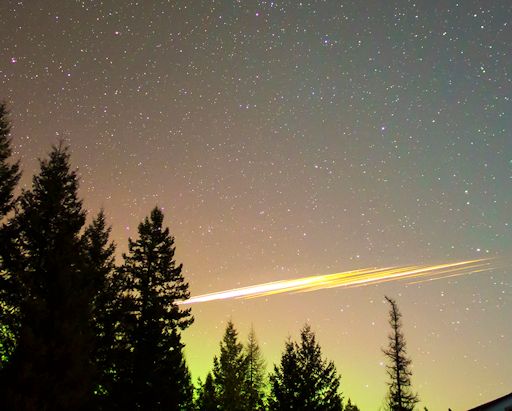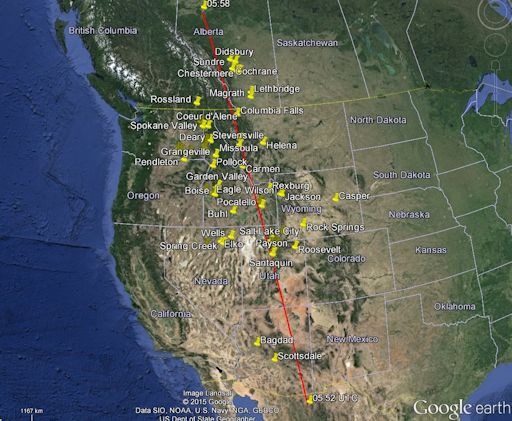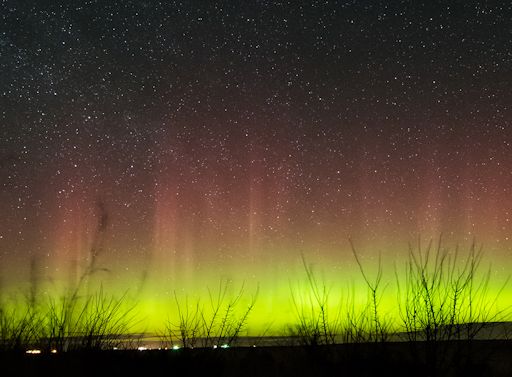CHINESE ROCKET RE-ENTRY: Last night, Feb. 23-24, sky watchers in the western half of North America witnessed a spectacular cluster of fireballs and meteors. We now know it was the re-entry and breakup of a Chinese rocket body, specifically stage 3 of the CZ-4B rocket that launched the
Yaogan Weixing 26 satellite in Dec. 2014. Donny Mott photographed the glowing debris from Spirit Lake, Idaho:
Mott was watching last night's display of auroras around 10 pm local time when the fragments flew by. "It was super bright," he says. "You can see it breaking up in these
4 images I took 10 seconds apart."
Another photographer, John Arnold, caught the meteor flying over Craig, Montana:
photos.
According to satellite tracking expert Ted Molczan, "there are
confirmed sightings from Arizona, Utah, Nevada, Wyoming, Idaho, Oregon, Washington, Montana, British Columbia, Alberta. The most southerly observation I have noted so far was from Scottsdale, Arizona; the most northerly from Didsbury, Alberta. That spans nearly 3000 km of the descent." Molczan has prepared a map of sightings along with the ground track of the decaying rocket body:
The re-entering rocket body traveled from south to north. Molczan says "the approximate toe of the debris footprint (should any have survived to impact Earth) would be well into Canada."
Monitor the realtime photo gallery for more sightings:
SOLAR WIND SPARKS AURORAS: A solar wind stream continues to gently buffet Earth's magnetic field. Last night, Feb. 23-24, a
G1-class geomagnetic storm broke out, causing an outburst of auroras around the Arctic Circle. At the peak of the disturbance, Northern Lights spilled across Canadian Border into upper-tier US states including
Washington,
Montana,
Idaho and, shown here, South Dakota:
"The lights were visible to the unaided eye and quite bright at times," says photographer Randy Halverson of Kennebec, SD.
The storm also sparked Southern Lights. New Zealand photographer Ian Griffin reports "an amazing night of auroras in Dunedin, Otago. We witnessed a display that lasted well over 4 hours with many pleasing beams and colors!"
See his photosMore auroras could be in the offing. NOAA forecasters estimate a 20% chance of geomagnetic storms on Feb. 24-25 as the solar wind continues to blow.
Aurora alerts: text,
voice




 Reply With Quote
Reply With Quote


 The Chinese launched another satellite on the Yaogan Weixing series on Saturday. Launch of Yaogan Weixing-26 took place at 03:22 UTC using a Long March-4B launch vehicle from the LC9 launch complex at the Taiyuan Satellite Launch Center.
The Chinese launched another satellite on the Yaogan Weixing series on Saturday. Launch of Yaogan Weixing-26 took place at 03:22 UTC using a Long March-4B launch vehicle from the LC9 launch complex at the Taiyuan Satellite Launch Center. As was the case in previous launches of the Yaogan Weixing series, analysts believe this class of satellites is used for military purposes.
As was the case in previous launches of the Yaogan Weixing series, analysts believe this class of satellites is used for military purposes. SAST began to develop the Chang Zheng-4B in February 1989. Originally, it was scheduled to be commissioned in 1997, but the first launch didn’t take place until late 1999. The modifications introduced on the Chang Zheng-4B included a larger satellite fairing and the replacement of the original mechanical-electrical control on the Chang Zheng-4 with an electronic control.
SAST began to develop the Chang Zheng-4B in February 1989. Originally, it was scheduled to be commissioned in 1997, but the first launch didn’t take place until late 1999. The modifications introduced on the Chang Zheng-4B included a larger satellite fairing and the replacement of the original mechanical-electrical control on the Chang Zheng-4 with an electronic control. Situated in the Kelan County in the northwest part of the Shanxi Province, the Taiyuan Satellite Launch Center (TSLC) is also known by the Wuzhai designation. It is used mainly for polar launches (meteorological, Earth resources and scientific satellites).
Situated in the Kelan County in the northwest part of the Shanxi Province, the Taiyuan Satellite Launch Center (TSLC) is also known by the Wuzhai designation. It is used mainly for polar launches (meteorological, Earth resources and scientific satellites).
Bookmarks